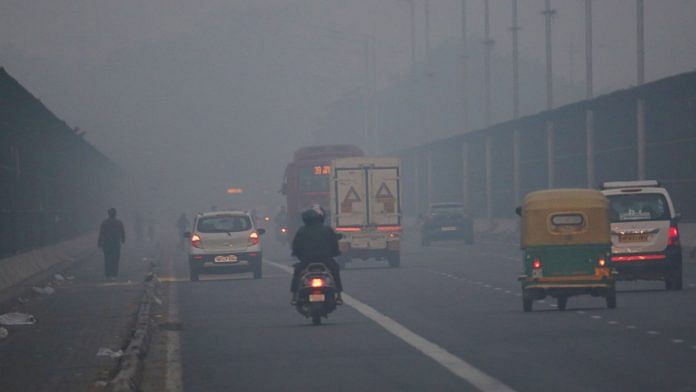New Delhi: The national capital woke up Wednesday to ‘poor’ air quality, for the first time this season, with the air quality index (AQI) hitting 207 at 10 am, according to the bulletin shared by the Central Pollution Control Board (CPCB) on its website.
Since 21 September, incidents of stubble burning, a major contributor to Delhi pollution in winter months, have been increasing in the neighbouring states of Punjab and Haryana.
According to the government’s pollution forecasting system SAFAR, as many as 336 farm fires were observed around Punjab, Haryana, and neighbouring border regions on 6 October.
Wind direction and speed will allow emission to get transported to Delhi, and the local conditions in the city itself are conducive for accumulation of pollutants. AQI is likely to deteriorate for the next three days and remain in ‘poor’ category with increasing magnitude until 10 October, said the bulletin.
However, the impact of the stubble burning on Delhi air quality had so far remained marginal due to the wind conditions. Over the last two weeks, the air quality remained moderate. As of 4 pm Tuesday, the AQI of Delhi was 178.
In the early hours of Wednesday, the AQI in Delhi’s Anand Vihar was 402 — in the ‘severe’ category. At 10 am, the AQI at the station improved to 253.
Mundka was in the ‘very poor’ category with AQI at 309, while Wazirpur had ‘poor’ air quality with AQI at 269. The AQI of Bawana, Jahangirpuri and Dwarka were at 258, 257, and 246, respectively.
According to the CPCB bulletin from 6 October, a number of cities are already experiencing poor air quality — Baghpat, Bhiwadi, Bulandshahr, Dharuhera, Gwalior, Lucknow, Mandi Gobindgarh, Meerut, Moradabad and Yamunagar. Charkhi Dadri in Haryana was in the ‘very poor’ category.
Also read: Delhi govt to spray bio-decomposer from 11 October to prevent stubble burning
Along predicted lines
Experts had predicted that the reopening of the economy after the Covid lockdown, along with the stubble burning incidents, would cause Delhi’s air to deteriorate — just like it does every winter.
Last year, a study had noted that the air pollution levels in Delhi had deteriorated by 25 per cent. However, air quality levels are still much worse than acceptable standards.
According to the WHO guidelines on air quality, PM2.5 should not exceed the yearly average 10 micrograms per cubic metre (μg/m³), or 24-hour average of 25 μg/m³. Similarly, PM10 should not exceed 20 μg/m³ annual mean, or 50 μg/m³ 24-hour mean.
AQI range
AQI under 50 is considered ‘good’; between 51 and 100 is categorised as satisfactory; moderate category is defined as AQI in 101-200 range, which cause breathing discomfort to the people with lungs, asthma and heart diseases.
‘Poor’ air quality — which causes breathing discomfort to most people on prolonged exposure — is defined as AQI between 201 to 300.
If air quality is between 301 and 400, air quality is described as very poor, and can cause respiratory illness on prolonged exposure. Above 500, air quality is considered to be ‘severe’. It affects healthy people and seriously impacts those with existing diseases.
Also read: Modi govt is considering shutting down old, polluting thermal power plants






